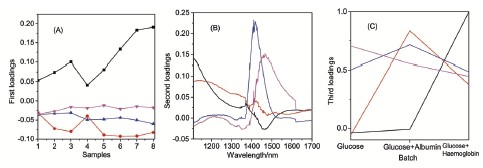| [1] Malin, S. F.; Ruchti, T. L.; Blank, T. B.; Thennadil, S. N.; Monfre, S. L. Clin. Chem. 1999, 45, 1651. [2] Klonoff, D. C. Diabetes Care 1997, 20, 433. [3] Arnold, M. A.; Small, G. W. Anal. Chem. 2005, 77, 5429. [4] Kondepati, V. R.; Heise, H. M. Anal. Bioanal. Chem. 2007, 388, 545. [5] Maruo, K.; Tsurugi, M.; Chin, J.; Ota, T.; Arimoto, H.; Yamada, Y.; Tamura, M.; Ishii, M.; Ozaki, Y. IEEE J. Sel. Top. Quantum Electron. 2003, 9, 322.[6] Arnold, M. A.; Liu, L.-Z.; Olesberg, J. T. J. Diabetes Sci. Technol. 2007, 1, 454.[7] Olesberg, J. T.; Liu, L.-Z. Anal. Chem. 2006, 78, 215.[8] Ozaki, Y. Anal. Sci. 2012, 28, 545.[9] Shao, X.-G.; Ning, Y.; Liu, F.-X.; Li, J.-H.; Cai, W.-S. Acta Chim. Sinica 2012, 70, 2109. (邵学广, 宁宇, 刘风霞, 李积慧, 蔡文生, 化学学报, 2012, 70, 2109.)[10] Chu, X.-L. Molecular Spectroscopy Analytical Technology Combined with Chemometrics and Its Application, Chemical Industry Press, Beijing, 2011. (禇小立, 化学计量学方法与分子光谱分析技术, 化学工业出版社, 北京, 2011.)[11] Shinzawa, H.; Nishida, M.; Kanematsu, W.; Tanaka, T.; Suzuki, K.; Noda, I. Analyst 2012, 137, 1913.[12] Andersson, C. A.; Bro, R. Chemom. Intell. Lab. Syst. 2000, 52, 1.[13] Bro, R. Chemom. Intell. Lab. Syst. 1997, 38, 149.[14] Peinado, A. C.; van den Berg, F.; Blanco, M.; Bro, R. Chemom. Intell. Lab. Syst. 2006, 83, 75.[15] Alm, E.; Bro, R.; Engelsen, S. B.; Karlberg, B.; Torgrip, R. J. O. Anal. Bioanal. Chem. 2007, 388, 179.[16] Cordella, C. B. Y.; Leardi, R.; Rutledge, D. N. Chemom. Intell. Lab. Syst. 2011, 106, 125.[17] Wang, K.; Jia, Z.-H.; Zhang, Z.-Q.; Li, H. Chem. J. Chin. Univ. 2009, 30, 268. (王康, 贾泽慧, 张志琪, 李华, 高等学校化学学报, 2009, 30, 268.)[18] Wang, L.-H.; Jacques, S. L.; Zheng, L. Q. Comput. Meth. Prog. Bio. 1995, 47, 131.[19] Maruo, K.; Oota, T.; Tsurugi, M.; Nakagawa, T.; Arimoto, H.; Tamura, M.; Ozaki, Y.; Yamada, Y. Appl. Spectrosc. 2006, 60, 441.[20] http://www.models.life.ku.dk/source/nwaytoolbox/ |
